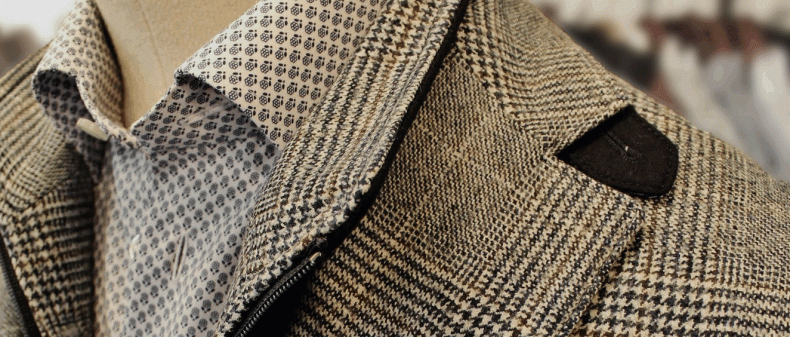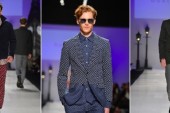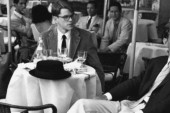
 Photo: Theodore 1922
Photo: Theodore 1922
I love buying clothes, but I hate spending money. This is probably because I’ve never had any money, although I’ve always found the funds for books and backpacking trips.
Fortunately, I have been able to assemble a wardrobe of vintage finds and fast fashion knock-offs. At the end of high school, I began buying tweed jackets from Value Village. I enjoyed their patterns and rough texture, and the way they curved along my back. They made me feel like a hip professor and were like nothing the boys at school were wearing.
By the time I reached university, tweed jackets were being mass produced by stores like H&M and Le Chateau. I would never suggest that I started the trend, but I will say that I liked them before they were everywhere. While pricier than my Value Village rescues, these jackets would cost around fifty dollars. While it’s a relief to your credit card, you do have to wonder where companies cut down on costs. It’s usually the manufacturing.
Traditional tweed is expensive because it’s hand woven on looms– an intensive, highly skilled endeavor. Harris Tweeds (which, like Champaign, legally must be made in the location of their name: Harris or the other isles of the Outer Hebrides) got their distinctive colours from the natural flora of Scotland. Warm and water-resistant, tweed was the ideal material for hunting stag on the soggy moors.
The symbol of Harris Tweed is a sovereign orb, which, by the time tweed had been rediscovered by a new generation, Vivienne Westwood nicked for her logo. Now I realize that I had once owned a genuine Harris jacket, which I probably bought for ten dollars, but had since foolishly given away. I don’t know if it’s the autumnal weather or my job writing for the Style section here at the Standard, but I had recently been aching for a tweed jacket; a genuine one, not a knock-off or hand me down.
But I was loathe to spend the money. I was complaining about this over maple-flavoured beer to my girlfriends when they ganged up on me.
“Real clothes cost money,” one said.
“You know I’m not a girly girl,” the other chimed in. “I don’t care about purses or jewelry or anything like that. But I wanted this nice leather bag from Roots. My Mom bought it for me for Christmas and it’s the most expensive thing I own. But it’s an investment, it will age really well and I’ll own it forever.”
It hit me that I was thinking about clothing all wrong. Because I never spent that much on my clothes, I thought of them as expendable, like magazines. I leave both these things lying on my floor. I needed to think of clothing like books: worth investing in, holding onto, and brimming with potentials. Covering World MasterCard Fashion Week for the Standard was as good an opportunity as any for a new look.
I had always noticed the clever window displays at Theodore 1922, a men’s suit shop in the Annex. Window display being one of the oldest forms of advertising (as soon as shops had windows, they put stuff in them), it’s endearing that, in our era of iPhone check-ins, a well-designed window can still lure us in. Miranda Black opened the store six years ago and, with products that range from conservative to fashion-forward, seeks to dress men from Bay Street to the gay village. Theodore 1922 has definitely benefited from the revival of gentlemanly dressing, and Black jokes that she has trouble keeping bowties in stock.
As we talk, Black’s dog Chloe, a white Boxer with a ring around her eye and who serves as the shop’s mascot, pads around the store quietly, nuzzling up to people’s legs.
“Because tweed is often a mixture of colours, it’s easy to wear,” she explains. She points to a multi-hued jacket. “You can wear this with black pants, grey pants, blue pants. Any kind of pant.” Black’s favourite is Donegal tweed, which originated in County Donegal, Ireland. It’s known for its barely perceptible flecks of bright colour. (As with Harris tweed, the original dyes were natural: blackberries, fuchsia and moss.)
While it has the weight and structure of a formal garment, a tweed jacket’s main attraction is its wearability.
“Guys go for easy stuff,” Black jokes. “It goes with everything. You can go drinking in it, but you can also go to a wedding.”
“In Ireland,” I add, “you may have to do both in the same day.” I ask if the tweed jacket is to men what the little black dress is for women.
“I don’t even know if there’s an equivalent for women. I don’t think we really have something that’s that versatile. The little black dress you don’t wear to morning brunch, but you can wear a tweed jacket.”
When picking one out for myself, I first lean towards Donegal. I wear a lot of bright colours and I loved the fact that they could be echoed in flecks of red, yellow and green. But Black leads me towards a darker jacket, with a checked pattern of navy and aubergine. When we pair it with blue and red shirts, the jacket that first looked dull charcoal springs to life.
The speckled nature of tweed also helps disguise stains, which is a major plus for me, as I’m a notorious spiller. (I sipped my complimentary coffee delicately by bowing low towards the cup rather than picking it up and risk dribbling. I was laughed at.)
Having never been fitted for a suit before, I noted how the structure of the jacket immediately makes you stand differently, back a little straighter, shoulders back. I learned exactly how long the arms are meant to hang, and which button to do up. I kept buttoning the lower of the two. Black corrected me by doing up the higher one.
“You’re not the first young man to do up the lower one,” she said. “Why is that?”
“It moves the cinch down lower on your body,” I explained, “And hides any tummy, if you have any.”
“Maybe it’s the new thing,” said Black, before adding, “If you write about it, don’t say I said to do it. It’s incorrect.”
When I looked at myself in the mirror, I saw a dandy. I saw Cary Grant. I saw Hamish Bowles, Editor at Large for Vogue. In short, I saw myself the way I want to be seen: as a fashion writer.
For men in their twenties, it’s become increasingly easy to never venture out of The Social Network uniform of jeans, t-shirts, and hoodies. These clothes are easy, comfortable and affordable. On the right person, they can be elevated to fashion. But clothes are not to be slept in. A more rigid structure forces you to hold yourself formally, wordlessly demanding to be taken seriously. Suits are ceremonial costumes that signify a defined role and responsibility. In the right context, a tweed jacket is as important as a top hat or wedding gown.
____
Max Mosher writes about style for Toronto Standard. You can follow him on Twitter at @max_mosher_.
For more, follow us on Twitter @TorontoStandard or subscribe to our newsletter.














